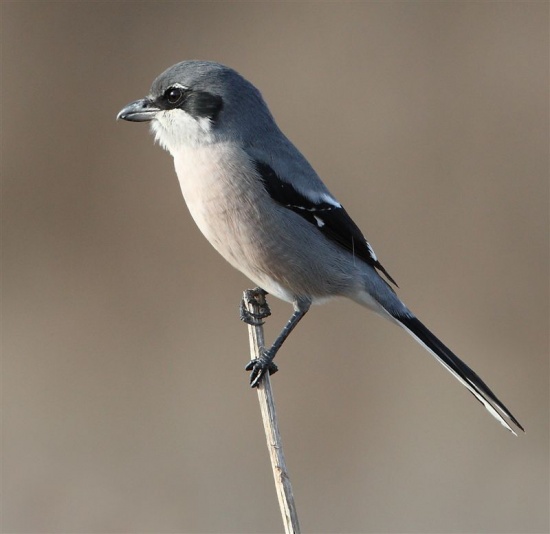Nutcracker (talk | contribs) m (format) |
Nutcracker (talk | contribs) (better pic) |
||
| Line 18: | Line 18: | ||
==Taxonomy== | ==Taxonomy== | ||
| − | [[Image: | + | [[Image:Steppe Grey Shrike, IOM.jpg|thumb|350px|right|''L. m. pallidirostris''<br />Photo by {{user|CJW|CJW}}<br /> [[Isle of Man]], July 2003]] |
Complex, and much disputed. In the past, lumped in [[Great Grey Shrike]], and some authors still treat many of the subspecies listed below in it<sup>[[#References|[4]]]</sup>. ''L. m. pallidirostris'' from the steppes of central Asia is sometimes considered a full species called '''Steppe Grey Shrike'''<sup>[[#References|[3]]]</sup>. | Complex, and much disputed. In the past, lumped in [[Great Grey Shrike]], and some authors still treat many of the subspecies listed below in it<sup>[[#References|[4]]]</sup>. ''L. m. pallidirostris'' from the steppes of central Asia is sometimes considered a full species called '''Steppe Grey Shrike'''<sup>[[#References|[3]]]</sup>. | ||
Revision as of 16:35, 16 September 2016
- Lanius meridionalis
Alternative name: Iberian Grey Shrike
Includes: Steppe Grey Shrike
Identification
Length 24-25 cm, weight 50-70 g
A large grey shrike, very variable in the grey tones of the plumage (see further under Subspecies, below), though with fairly consistent pattern; much overlap in characters with Great Grey Shrike. Crown, mantle and rump grey; black 'mask' with or without a narrow white supercilium; inner scapulars usually white; wing black with small to large white patch at base of primaries; secondaries and tertials with small to large white tips; tail long, black-centred with white edges; underparts pinkish-grey, white, or dusky grey; bill black (pale-based in juveniles).
Distribution
Southern Europe, north Africa, and the steppes of central Asia:
Europe: France, Corsica, Portugal, Spain, Canary Islands, Gran Canaria, Lanzarote, Tenerife
Northern Africa: Morocco, Algeria, Tunisia, Libya, Egypt
Western Africa: Mauritania, Senegambia, Senegal, The Gambia, Mali, Burkina Faso, Nigeria, Niger, Chad, Cameroon
Eastern Africa: Sudan, Eritrea, Ethiopia, Djibouti, Somalia
Middle East: Turkey, Syria, Lebanon, Israel, Jordan, Arabian Peninsula, Saudi Arabia, Yemen, Socotra, Oman, United Arab Emirates, Kuwait, Iraq, Iran, Armenia, Azerbaijan, Georgia
Asia: Kazakhstan, Uzbekistan, Turkmenistan, Tajikistan, Mongolia, northwesternmost China, northern Pakistan, northwestern India
Taxonomy
Complex, and much disputed. In the past, lumped in Great Grey Shrike, and some authors still treat many of the subspecies listed below in it[4]. L. m. pallidirostris from the steppes of central Asia is sometimes considered a full species called Steppe Grey Shrike[3].
Subspecies
Twelve subspecies (listed below) are currently recognised by the Clements list[1], eleven by HBW[2], ten by IOC[3], while Svensson et al. treat it as monotypic with all the other subspecies below included in Great Grey Shrike[4].
- L. m. meridionalis: Iberian Grey Shrike
- Iberian Peninsula and southern France
- Upperparts dark grey, underparts pinkish-grey except for white throat
- L. m. koenigi:
-
- Upperparts dark grey, underparts light grey; similar to L. m. algeriensis but slightly smaller
- L. m. algeriensis:
-
- Upperparts dark grey, underparts light grey
- L. m. elegans:
- Northern Sahara (south of Atlas Mountains, also Mauritania to Sinai Peninsula and Red Sea)
- Upperparts light grey, underparts white
- L. m. leucopygos:
-
- Upperparts very light grey, rump and underparts white
- L. m. aucheri:
- West coast of Red Sea to southern Iran and Arabian Peninsula
- Upperparts mid grey, underparts white
- L. m. theresae:
-
- Upperparts dark grey, underparts white; similar to L. m. aucheri but slightly darker above
- L. m. buryi:
-
- Darkest subspecies; very dark grey mantle, dusky grey below, supercilium and scapulars grey, not white
- L. m. uncinatus:
-
- Similar to L. m. aucheri but with less white on scapulars, and slightly longer bill
- L. m. jebelmarrae:
- Western Sudan (Darfur)
- Intermediate between L. m. aucheri and L. m. leucopygos; included in L. m. leucopygos by HBW & IOC
- L. m. lahtora:
-
- Upperparts mid grey, underparts white; similar to L. m. aucheri but more extensive white on secondary tips, and black mask extends across top of bill
- L. m. pallidirostris: Steppe Grey Shrike
- Arid steppes of Kazakhstan to western China (Xinjiang, Gansu and Ningsia)
- Upperparts light grey, rump and underparts white; extensive white in wings; black mask narrow; bill often pale-based even in some adults (though black in many adults)
Habitat
Dry open country.
Behaviour
Behaviour is similar to other shrikes, using prominent perches and impaling corpses on thorns and barbed wire spikes.
Migration
Mostly resident or short-distance nomadic, but L. m. pallidirostris often migratory, many moving to northeast Africa as far south as Ethiopia and Somalia.
Diet
The diet includes large insects, small birds, rodents and lizards.
References
- Clements, J. F., T. S. Schulenberg, M. J. Iliff, D. Roberson, T. A. Fredericks, B. L. Sullivan, and C. L. Wood. 2014. The eBird/Clements checklist of birds of the world: Version 6.9., with updates to August 2014. Downloaded from http://www.birds.cornell.edu/clementschecklist/download/
- Del Hoyo, J, A Elliott, and D Christie, eds. 2008. Handbook of the Birds of the World. Volume 13: Penduline-tits to Shrikes. Barcelona: Lynx Edicions. ISBN 978-8496553453
- Gill, F and D Donsker (Eds). 2016. IOC World Bird Names (version 6.3). Available at http://www.worldbirdnames.org/.
- Svensson, L., et al. (2009). Collins Bird Guide, 2nd ed., revised. Collins.
Recommended Citation
- BirdForum Opus contributors. (2024) Iberian Grey Shrike. In: BirdForum, the forum for wild birds and birding. Retrieved 23 April 2024 from https://www.birdforum.net/opus/Iberian_Grey_Shrike
External Links






